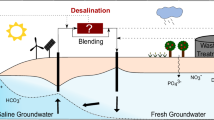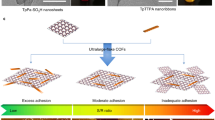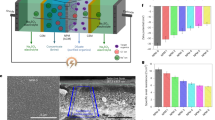Abstract
High-salinity organic wastewaters pose a major challenge for conventional wastewater treatment processes. Here we propose dialysis as an innovative solution to overcome this challenge. Dialysis uses an ultrafiltration (UF) membrane that allows the passage of salts while rejecting the organic substances, operating in a bilateral countercurrent flow mode without the application of hydraulic pressure. Using bench-scale experiments and a model for salt and water transport in leaky membranes, we demonstrate that dialysis can effectively desalinate high-salinity organic wastewaters without diluting the wastewater stream. By comparing the salt/organic selectivity of dialysis and UF using the same membrane, we show that dialysis can effectively fractionate salts and organic substances in high-salinity organic wastewaters. Additionally, we find that, unlike UF, dialysis is almost unaffected by membrane fouling, highlighting its excellent fouling resistance. We conclude by proposing potential high-salinity organic wastewater treatment schemes based on dialysis, paving the way for more sustainable and effective management of challenging wastewaters.
This is a preview of subscription content, access via your institution
Access options
Subscribe to this journal
Receive 12 digital issues and online access to articles
$119.00 per year
only $9.92 per issue
Buy this article
- Purchase on SpringerLink
- Instant access to full article PDF
Prices may be subject to local taxes which are calculated during checkout





Similar content being viewed by others
Data availability
Source data are provided with this paper. Source data for figures are also available publicly via Figshare at https://doi.org/10.6084/m9.figshare.26309704 (ref. 59).
References
Lefebvre, O. & Moletta, R. Treatment of organic pollution in industrial saline wastewater: a literature review. Water Res. 40, 3671–3682 (2006).
Warner, N. R., Christie, C. A., Jackson, R. B. & Vengosh, A. Impacts of shale gas wastewater disposal on water quality in western pennsylvania. Environ. Sci. Technol. 47, 11849–11857 (2013).
Guo, N., Wang, Y., Tong, T. & Wang, S. The fate of antibiotic resistance genes and their potential hosts during bio-electrochemical treatment of high-salinity pharmaceutical wastewater. Water Res. 133, 79–86 (2018).
Elimelech, M. & Phillip, W. A. The future of seawater desalination: energy, technology, and the environment. Science 333, 712–717 (2011).
Xie, W. et al. Shale gas wastewater characterization: comprehensive detection, evaluation of valuable metals, and environmental risks of heavy metals and radionuclides. Water Res. 220, 118703 (2022).
De Vrieze, J., Coma, M., Debeuckelaere, M., Van der Meeren, P. & Rabaey, K. High salinity in molasses wastewaters shifts anaerobic digestion to carboxylate production. Water Res. 98, 293–301 (2016).
Zhang, W. et al. Impact of chloride ions on UV/H2O2 and UV/persulfate advanced oxidation processes. Environ. Sci. Technol. 52, 7380–7389 (2018).
Cao, T. N.-D. et al. An overview of deploying membrane bioreactors in saline wastewater treatment from perspectives of microbial and treatment performance. Bioresour. Technol. 363, 127831 (2022).
Wang, X. et al. Simultaneous purification of salt and condensate by collaborated evaporation-peroxodisulfate treatment of high salinity organic wastewater. Sep. Purif. Technol. 347, 127703 (2024).
Liu, J. & Wang, J. Experimental study on the mechanism and efficiency of a closed-cycle low-temperature evaporation system for treating high salt and high organic matter wastewater. J. Water Process. Eng. 58, 104926 (2024).
Zhang, X. Selective separation membranes for fractionating organics and salts for industrial wastewater treatment: design strategies and process assessment. J. Membr. Sci. 643, 120052 (2022).
Goh, P. S., Wong, K. C. & Ismail, A. F. Membrane technology: a versatile tool for saline wastewater treatment and resource recovery. Desalination 521, 115377 (2022).
Lin, J. et al. Fractionation of direct dyes and salts in aqueous solution using loose nanofiltration membranes. J. Membr. Sci. 477, 183–193 (2015).
Jiang, M. et al. Conventional ultrafiltration as effective strategy for dye/salt fractionation in textile wastewater treatment. Environ. Sci. Technol. 52, 10698–10708 (2018).
Li, M. et al. Fractionation and concentration of high-salinity textile wastewater using an ultra-permeable sulfonated thin-film composite. Environ. Sci. Technol. 51, 9252–9260 (2017).
Jiang, M. et al. Effective dye purification using tight ceramic ultrafiltration membrane. J. Membr. Sci. 566, 151–160 (2018).
Luo, X. et al. Energy-efficient trehalose-based polyester nanofiltration membranes for zero-discharge textile wastewater treatment. J. Hazard. Mater. 465, 133059 (2024).
Zhao, R. et al. Recycling the high-salinity textile wastewater by quercetin-based nanofiltration membranes with minimal water and energy consumption. Environ. Sci. Technol. 56, 17998–18007 (2022).
Cai, W. et al. New insights into membrane fouling formation during ultrafiltration of organic wastewater with high salinity. J. Membr. Sci. 635, 119446 (2021).
Arooj, A., Yin, J., Li, K., Li, M. & Zhang, X. Pressure-driven membranes for advanced treatment of textile wastewater: dye/salt fractionation, concentration, and cleaning strategies. Desalination 581, 117596 (2024).
Tu, S.-C., Ravindran, V. & Pirbazari, M. A pore diffusion transport model for forecasting the performance of membrane processes. J. Membr. Sci. 265, 29–50 (2005).
Dai, F. et al. Antifouling polyphenylene sulfone tight-ultrafiltration membrane by co-depositing dopamine and zwitterionic polymer for efficient dye/salt separation. Sep. Purif. Technol. 345, 127403 (2024).
Han, G., Feng, Y., Chung, T.-S., Weber, M. & Maletzko, C. Phase inversion directly induced tight ultrafiltration (UF) hollow fiber membranes for effective removal of textile dyes. Environ. Sci. Technol. 51, 14254–14261 (2017).
Himmelfarb, J., Vanholder, R., Mehrotra, R. & Tonelli, M. The current and future landscape of dialysis. Nat. Rev. Nephrol. 16, 573–585 (2020).
Pastan, S. & Bailey, J. Dialysis therapy. New Engl. J. Med. 338, 1428–1437 (1998).
Kerr, P. G. & Huang, L. Review: membranes for haemodialysis. Nephrology 15, 381–385 (2010).
BagaRao, S. & Ghista, D. N. in Biomedical Engineering of Pancreatic, Pulmonary, and Renal Systems, and Applications to Medicine (ed. Ghista, D.) 625–646 (Academic Press, 2023).
Yehl, C. J. & Zydney, A. L. High performance countercurrent membrane purification for protein separations. J. Membr. Sci. 633, 119396 (2021).
Yehl, C. J. & Zydney, A. L. Analysis of tradeoffs between purification factor and yield for high-performance countercurrent membrane purification for protein separations. Biotechnol. Prog. 38, e3221 (2022).
Mohammadzadehmarandi, A., Determan, A., Krumm, C., McIntosh, L. D. & Zydney, A. L. High-performance countercurrent membrane purification for host cell protein removal from monoclonal antibody products. Biotechnol. Bioeng. 120, 3585–3591 (2023).
Misra, M. Basic mechanisms governing solute and fluid transport in hemodialysis. Hemodial. Int. 12, S25–S28 (2008).
Wang, R., Zhang, J., Tang, C. Y. & Lin, S. Understanding selectivity in solute–solute separation: definitions, measurements, and comparability. Environ. Sci. Technol. 56, 2605–2616 (2022).
Wang, L. et al. Water transport in reverse osmosis membranes is governed by pore flow, not a solution-diffusion mechanism. Sci. Adv. 9, eadf8488 (2023).
Rasouli, M. Basic concepts and practical equations on osmolality: biochemical approach. Clin. Biochem. 49, 936–941 (2016).
Zhao, Y. et al. Differentiating solutes with precise nanofiltration for next generation environmental separations: a review. Environ. Sci. Technol. 55, 1359–1376 (2021).
Johnson, D., Hashaikeh, R. & Hilal, N. in Osmosis Engineering (eds Hilal, N. et al.) 1–15 (Elsevier, 2021).
Wang, L. et al. Salt and water transport in reverse osmosis membranes: beyond the solution-diffusion model. Environ. Sci. Technol. 55, 16665–16675 (2021).
Shen, L., Li, P. & Zhang, T. Green and feasible fabrication of loose nanofiltration membrane with high efficiency for fractionation of dye/NaCl mixture by taking advantage of membrane fouling. J. Appl. Polym. Sci. 136, 47438 (2019).
Shao, J., Hou, J. & Song, H. Comparison of humic acid rejection and flux decline during filtration with negatively charged and uncharged ultrafiltration membranes. Water Res. 45, 473–482 (2011).
Chang, S., Waite, T. D., Schäfer, A. I. & Fane, A. G. Adsorption of trace steroid estrogens to hydrophobic hollow fibre membranes. Desalination 146, 381–386 (2002).
Bellona, C., Drewes, J. E., Xu, P. & Amy, G. Factors affecting the rejection of organic solutes during NF/RO treatment—a literature review. Water Res. 38, 2795–2809 (2004).
Coates, E. Aggregation of dyes in aqueous solutions. J. Soc. Dye. Colour. 85, 355–368 (1969).
Chen, Z., Lohr, A., Saha-Möller, C. R. & Würthner, F. Self-assembled π-stacks of functional dyes in solution: structural and thermodynamic features. Chem. Soc. Rev. 38, 564–584 (2009).
Lu, X. et al. Relating selectivity and separation performance of lamellar two-dimensional molybdenum disulfide (MoS2) membranes to nanosheet stacking behavior. Environ. Sci. Technol. 54, 9640–9651 (2020).
Ahmad, N. N. R., Ang, W. L., Leo, C. P., Mohammad, A. W. & Hilal, N. Current advances in membrane technologies for saline wastewater treatment: a comprehensive review. Desalination 517, 115170 (2021).
Horseman, T. et al. Wetting, scaling, and fouling in membrane distillation: state-of-the-art insights on fundamental mechanisms and mitigation strategies. ACS EST Eng. 1, 117–140 (2021).
Peter-Varbanets, M., Margot, J., Traber, J. & Pronk, W. Mechanisms of membrane fouling during ultra-low pressure ultrafiltration. J. Membr. Sci. 377, 42–53 (2011).
Kimura, K. & Kume, K. Irreversible fouling in hollow-fiber PVDF MF/UF membranes filtering surface water: effects of precoagulation and identification of the foulant. J. Membr. Sci. 602, 117975 (2020).
Song, L. & Elimelech, M. Particle deposition onto a permeable surface in laminar flow. J. Colloid Interface Sci. 173, 165–180 (1995).
Virtanen, T. et al. Analysis of membrane fouling by Brunauer–Emmett–Teller nitrogen adsorption/desorption technique. Sci. Rep. 10, 3427 (2020).
Rudolph-Schöpping, G., Schagerlöf, H., Jönsson, A.-S. & Lipnizki, F. Comparison of membrane fouling during ultrafiltration with adsorption studied by quartz crystal microbalance with dissipation monitoring (QCM-D). J. Membr. Sci. 672, 121313 (2023).
Xie, M., Lee, J., Nghiem, L. D. & Elimelech, M. Role of pressure in organic fouling in forward osmosis and reverse osmosis. J. Membr. Sci. 493, 748–754 (2015).
Straub, A. P., Lin, S. & Elimelech, M. Module-scale analysis of pressure retarded osmosis: performance limitations and implications for full-scale operation. Environ. Sci. Technol. 48, 12435–12444 (2014).
Cheng, H.-H., Narindri, B., Chu, H. & Whang, L.-M. Recent advancement on biological technologies and strategies for resource recovery from swine wastewater. Bioresour. Technol. 303, 122861 (2020).
She, Q., Wang, R., Fane, A. G. & Tang, C. Y. Membrane fouling in osmotically driven membrane processes: a review. J. Membr. Sci. 499, 201–233 (2016).
Tong, T. & Elimelech, M. The global rise of zero liquid discharge for wastewater management: drivers, technologies, and future directions. Environ. Sci. Technol. 50, 6846–6855 (2016).
Zhang, C. et al. Designing a next generation solar crystallizer for real seawater brine treatment with zero liquid discharge. Nat. Commun. 12, 998 (2021).
Zhou, Z. et al. Precise sub-angstrom ion separation using conjugated microporous polymer membranes. ACS Nano 15, 11970–11980 (2021).
Chen, Y. Dialysis opens a new pathway for high-salinity organic wastewater treatment. Figshare https://doi.org/10.6084/m9.figshare.26309704 (2024).
Chen, Y., Kim, S. & Cohen, Y. Tuning the hydraulic permeability and molecular weight cutoff (MWCO) of surface nano-structured ultrafiltration membranes. J. Membr. Sci. 629, 119180 (2021).
Acknowledgements
We thank the financial support from the Basic Science Center Project of the National Natural Science Foundation of China (52388101).
Author information
Authors and Affiliations
Contributions
Y.C. and Z.W. designed the experiment and wrote the initial draft. Longchao W. performed the experiments. Y.C. and Li W. conducted model development and data fitting. M.d.C. and X.Z. assisted in interpreting the results and revised the manuscript. Z.W. and M.E. conceived the idea, supervised the research and revised the manuscript. All authors participated in the discussion.
Corresponding authors
Ethics declarations
Competing interests
The authors declare no competing interests.
Peer review
Peer review information
Nature Water thanks the anonymous reviewers for their contribution to the peer review of this work.
Additional information
Publisher’s note Springer Nature remains neutral with regard to jurisdictional claims in published maps and institutional affiliations.
Supplementary information
Supplementary Information
Supplementary Text 1–6, Tables 1 and 2 and Figs. 1–14.
Supplementary Data 1
Data for Supplementary Figs. 2–6, 9–11 and 14.
Source data
Source Data Fig. 2
Data for Fig. 2.
Source Data Fig. 3
Data for Fig. 3.
Source Data Fig. 4
Data for Fig. 4.
Rights and permissions
Springer Nature or its licensor (e.g. a society or other partner) holds exclusive rights to this article under a publishing agreement with the author(s) or other rightsholder(s); author self-archiving of the accepted manuscript version of this article is solely governed by the terms of such publishing agreement and applicable law.
About this article
Cite this article
Chen, Y., Wang, L., del Cerro, M. et al. Dialysis opens a new pathway for high-salinity organic wastewater treatment. Nat Water 3, 49–58 (2025). https://doi.org/10.1038/s44221-024-00368-6
Received:
Accepted:
Published:
Issue date:
DOI: https://doi.org/10.1038/s44221-024-00368-6



